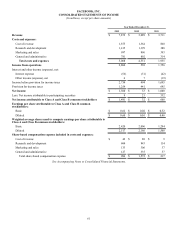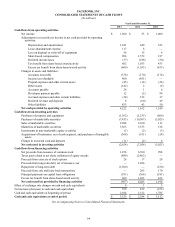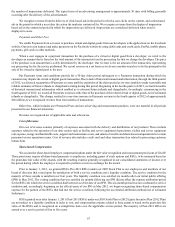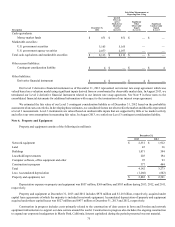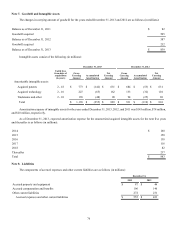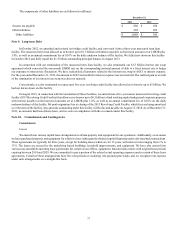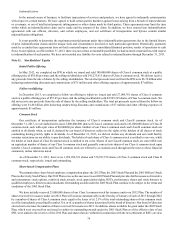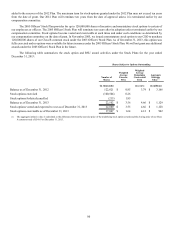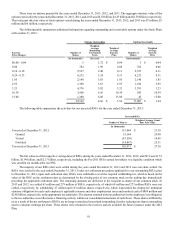Facebook 2013 Annual Report Download - page 73
Download and view the complete annual report
Please find page 73 of the 2013 Facebook annual report below. You can navigate through the pages in the report by either clicking on the pages listed below, or by using the keyword search tool below to find specific information within the annual report.71
Foreign Currency
Generally the functional currency of our international subsidiaries is the local currency. We translate the financial statements of
these subsidiaries to U.S. dollars using month-end rates of exchange for assets and liabilities, and average rates of exchange for revenue,
costs, and expenses. Translation gains and losses are recorded in accumulated other comprehensive income as a component of stockholders'
equity. Net losses resulting from foreign exchange transactions were $14 million, $9 million, and $29 million for the years ended
December 31, 2013, 2012, and 2011, respectively. These losses were recorded as other income (expense), net on our consolidated
statements of income.
Credit Risk and Concentration
Financial instruments owned by the company that are potentially subject to concentrations of credit risk consist primarily of cash,
cash equivalents, restricted cash, marketable securities, accounts receivable, and derivative instruments. Cash equivalents consist of short-
term money market funds and U.S. government and U.S. government agency securities, which are managed by reputable financial
institutions. Marketable securities consist of investments in U.S. government and U.S. government agency securities. Our investment
policy limits investment instruments to U.S. government and U.S. government agency securities with the main objective of preserving
capital and maintaining liquidity.
Accounts receivable are typically unsecured and are derived from revenue earned from customers across different industries and
countries. We generated 46%, 51%, and 56% of our revenue for the years ended December 31, 2013, 2012, and 2011, respectively, from
marketers and developers based in the United States, with the majority of revenue outside of the United States coming from customers
located in western Europe, Canada, Australia, and Brazil.
We perform ongoing credit evaluations of our customers, and generally do not require collateral. We maintain an allowance for
estimated credit losses. During the years ended December 31, 2013, 2012, and 2011, our bad debt expenses were $21 million, $9 million,
and $8 million, respectively. In the event that accounts receivable collection cycles deteriorate, our operating results and financial position
could be adversely affected.
No customer represented 10% or more of total revenue during the years ended December 31, 2013 and 2012 and one customer
represented 12% of total revenue for the year ended December 31, 2011.
Segments
Our chief operating decision-maker is our Chief Executive Officer who reviews financial information presented on a consolidated
basis. There are no segment managers who are held accountable by the chief operating decision-maker, or anyone else, for operations,
operating results, and planning for levels or components below the consolidated unit level. Accordingly, we have determined that we
have a single reporting segment and operating unit structure.
Recently Issued and Adopted Accounting Pronouncement
Comprehensive Income
In February 2013, the FASB issued ASU No. 2013-02, Comprehensive Income (Topic 220): Reporting of Amounts Reclassified
Out of Accumulated Other Comprehensive Income (ASU 2013-02), which is effective prospectively for public companies for reporting
periods beginning after December 15, 2012. This new accounting standard improves the reporting of reclassifications out of accumulated
other comprehensive income (AOCI) by requiring an entity to report the effect of significant reclassifications out of AOCI on the respective
line items in net income if the amount being reclassified is required under GAAP to be reclassified in its entirety to net income. For other
amounts that are not required under GAAP to be reclassified in their entirety to net income in the same reporting period, an entity is
required to cross-reference other disclosures required under GAAP that provide additional detail about those amounts. We adopted this
new guidance on January 1, 2013 and the adoption did not have a material effect on our consolidated financial statements.
Note 2. Acquisitions
During the year ended December 31, 2013, we completed several business acquisitions for total consideration of $363 million,
consisting of approximately $285 million in cash and 3 million vested shares of our Class A common stock which are not conditioned
upon continuous employment. In addition, we issued approximately 6 million shares of Class A common stock in connection with such
acquisitions, which are conditioned upon continuous employment. These shares have been excluded from purchase consideration and
will be recognized over the required service period as share-based compensation expense.
Pro forma results of operations related to our acquisitions during the year ended December 31, 2013 have not been presented
because they are not material to our consolidated statements of income, either individually or in the aggregate.


